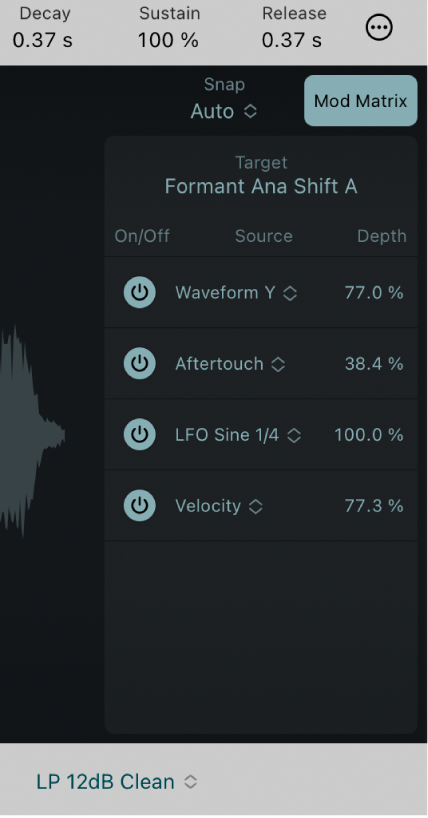Logic Pro User Guide for iPad
-
- What is Logic Pro?
- Working areas
- Work with function buttons
- Work with numeric values
-
- Intro to tracks
- Create tracks
- Create tracks using drag and drop
- Choose the default region type for a software instrument track
- Select tracks
- Duplicate tracks
- Reorder tracks
- Rename tracks
- Change track icons
- Change track colors
- Use the tuner on an audio track
- Show the output track in the Tracks area
- Delete tracks
- Edit track parameters
- Start a Logic Pro subscription
- How to get help
-
- Intro to recording
-
- Before recording software instruments
- Record software instruments
- Record additional software instrument takes
- Record to multiple software instrument tracks
- Record multiple MIDI devices to multiple tracks
- Record software instruments and audio simultaneously
- Merge software instrument recordings
- Spot erase software instrument recordings
- Replace software instrument recordings
- Capture your most recent MIDI performance
- Route MIDI internally to software instrument tracks
- Record with Low Latency Monitoring mode
- Use the metronome
- Use the count-in
-
- Intro to arranging
-
- Intro to regions
- Select regions
- Cut, copy, and paste regions
- Move regions
- Remove gaps between regions
- Delay region playback
- Trim regions
- Loop regions
- Repeat regions
- Mute regions
- Split and join regions
- Stretch regions
- Separate a MIDI region by note pitch
- Bounce regions in place
- Change the gain of audio regions
- Create regions in the Tracks area
- Convert a MIDI region to a Session Player region or a pattern region
- Rename regions
- Change the color of regions
- Delete regions
-
- Intro to chords
- Add and delete chords
- Select chords
- Cut, copy, and paste chords
- Move and resize chords
- Loop chords on the Chord track
- Edit chords
- Work with chord groups
- Use chord progressions
- Change the chord rhythm
- Choose which chords a Session Player region follows
- Analyze the key signature of a range of chords
- Create fades on audio regions
- Extract vocal and instrumental stems with Stem Splitter
- Access mixing functions using the Fader
-
- Intro to Step Sequencer
- Use Step Sequencer with Drum Machine Designer
- Record Step Sequencer patterns live
- Step record Step Sequencer patterns
- Load and save patterns
- Modify pattern playback
- Edit steps
- Edit rows
- Edit Step Sequencer pattern, row, and step settings in the inspector
- Customize Step Sequencer
-
- Effect plug-ins overview
-
- Instrument plug-ins overview
-
- ES2 overview
- Interface overview
-
- Modulation overview
- Use the Mod Pad
-
- Vector Envelope overview
- Use Vector Envelope points
- Use Vector Envelope solo and sustain points
- Set Vector Envelope segment times
- Vector Envelope XY pad controls
- Vector Envelope Actions menu
- Vector Envelope loop controls
- Vector Envelope point transition shapes
- Vector Envelope release phase behavior
- Use Vector Envelope time scaling
- Modulation source reference
- Via modulation source reference
-
- Sample Alchemy overview
- Interface overview
- Add source material
- Save a preset
- Edit mode
- Play modes
- Source overview
- Synthesis modes
- Granular controls
- Additive effects
- Additive effect controls
- Spectral effect
- Spectral effect controls
- Filter module
- Low, bandpass, and highpass filters
- Comb PM filter
- Downsampler filter
- FM filter
- Envelope generators
- Mod Matrix
- Modulation routing
- Motion mode
- Trim mode
- More menu
- Sampler
- Studio Piano
- Copyright
Sample Alchemy Mod Matrix in Logic Pro for iPad
Sample Alchemy LFOs and envelopes are known as modulation generators. These modulation sources are used to control modulation targets, such as filter cutoff, source synthesis parameters, and source controls. You can assign up to four independent routings of modulation sources and targets in the Mod Matrix pane.
Sample Alchemy provides four LFOs and dedicated modulation and amplitude envelopes that can also be assigned as modulation sources or targets in the Mod Matrix pane.
Use the Mod Matrix to control how the sound changes as you move handles up and down the waveform using the Waveform Y modulator. Your keyboard modulation wheel, aftertouch, pitch bend, velocity, and MIDI continuous controller features can also be assigned as real-time control sources for Sample Alchemy parameters in the Mod Matrix pane.
When a parameter is the target of one or more modulators, an orange modulation arc is shown beside the blue value arc for the knob. This indicates that the knob is an active modulation target and shows the modulation range. The amount of depth you assign in the Mod Matrix pane determines how much a modulation source affects its target.
The Mod Matrix pane shows the modulators applied to the currently selected control in Sample Alchemy. This is shown via the Target field at the top of the Mod Matrix pane as well as by the dot that appears in the center of the currently selected knob.
If you’re new to synthesizers and the concepts behind modulation generators, such as LFOs and envelopes, see Intro to synthesizers.

Mod Matrix parameters
Mod Matrix button: Show or hide the Mod Matrix pane to assign up to four independent routings of modulation to a target.
Target pop-up menu: Displays the selected target. Tap a parameter to select a new modulation target.
On/Off button: Turn the row of source modulation for the selected target on or off.
Source pop-up menu: Choose a modulation source.
Depth field: Drag vertically to set the maximum value or intensity of modulation. You can also tap the field to enter a numerical value.
Download this guide: PDF